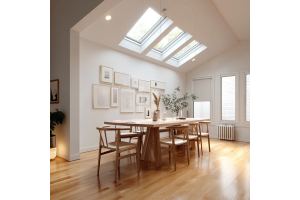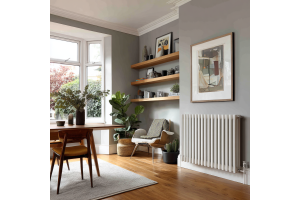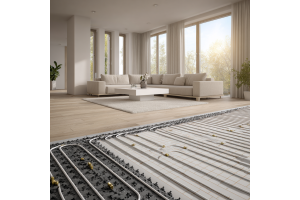
Choosing the right spot to fit your radiator is crucial for efficient heating and a comfortable home. While radiators are functional, their placement can significantly affect how well your space is heated. So, where is the best place to install a radiator?
When it comes to heating your home, radiators play a crucial role in ensuring that every room is warm and comfortable. But one often overlooked aspect of radiator installation is placement. The correct positioning of a radiator can significantly impact its heating efficiency, the aesthetic appeal of a room, and even your energy bills.
In this article, we’ll explore the key factors that should be considered when deciding where to fit a radiator. We’ll also cover different types of radiator placements for various spaces in your home, ensuring maximum heating effectiveness while maintaining an attractive living environment.
The answer is simple: under windows or next to windows on an outside wall. Here’s why this traditional placement is still the most effective for heating your home evenly.
1. Understand the Basics of Heat Distribution
Before we delve into the specifics of radiator placement, it’s important to understand how heat distributes in a room. Radiators work by emitting heat, which rises as warm air circulates. The location of your radiator will influence how the heat flows across the room and whether or not it spreads evenly.
The most efficient radiator placement ensures that the warm air circulates freely throughout the room without obstruction. Any object that blocks airflow or heat flow, such as large furniture, curtains, or even poorly placed radiators, will make the heating system less efficient.
2. Traditional Placement: Under Windows
Under the window has been a traditional and popular place for radiator installation, and for a good reason. This placement has been a standard for decades, and it continues to be an efficient strategy in many modern homes. Here’s why:
-
Counteracting cold drafts: Windows are typically the coldest part of a room as they allow heat to escape. Placing a radiator underneath helps warm the cold air that enters from the window, preventing drafts and maintaining a comfortable temperature.
-
Improved heat circulation: The warm air rises from the radiator and is immediately distributed across the room, circulating away from the window. This prevents cold spots from forming, especially in areas near the window.
-
Optimal space usage: Under windows is often an underutilized space. By placing a radiator there, you take advantage of this area without impeding your room’s layout or blocking valuable wall space.
While this placement is ideal for traditional radiators, the trend has evolved with modern heating systems, and there are now other innovative ways to maximize heating in a room. Still, under the window placement remains a strong and proven method.
Why Fit a Radiator Under or Next to a Window?
Windows are typically the coldest parts of a room, especially during the winter months. Placing a radiator beneath or next to a window creates a thermal barrier that helps combat cold air entering the room.
When warm air from the radiator rises, it mixes with the cool air from the window. This natural convection helps to distribute heat evenly throughout the room, ensuring you avoid cold spots.
The Benefits of Window and Outside Wall Placement
1. Even Heat Distribution
A radiator placed under or next to a window prevents the creation of a "hot side" and a "cold side" in the room. Instead, it ensures the warmth spreads uniformly, making your space more comfortable.
2. Combatting Draughts
Even well-insulated windows can let in a small amount of cold air. A radiator positioned here counteracts these draughts, preventing the room from feeling chilly.
3. Efficient Use of Space
In many homes, windows are located on external walls, which are otherwise unused for furniture or storage. Installing a radiator here maximizes wall space while maintaining effective heating.
4. Perfect Pairing with Vertical Radiators
For rooms with limited horizontal wall space—such as those with patio doors or tall windows—vertical radiators are an excellent solution. Placing a vertical radiator next to a window achieves the same effect as traditional horizontal models, without taking up valuable floor or wall space.
What Happens If You Place a Radiator on the Opposite Wall?
Positioning a radiator on the opposite wall from a window can lead to uneven heating. The warm air from the radiator rises and circulates within the room, but the cold air near the window remains largely unaffected. This results in a room with a distinct "hot side" near the radiator and a "cold side" by the window, making it less comfortable overall.
3. Fitting Radiators on External Walls
External walls are another common location for radiator installation. These walls are more prone to heat loss as they are exposed to the outside, meaning it’s essential to place your radiator where it can combat this loss effectively. Here's why this location works:
-
Efficient heat distribution: External walls tend to be cooler, so a radiator installed on these walls ensures that the warmth can help raise the temperature of the entire room. This placement can help counteract the heat loss from outside, especially in cold weather.
-
Prevention of cold spots: Without a radiator on external walls, cold spots could form in areas farthest from the heat source, especially near doors or windows. By positioning the radiator along the wall, you create an even distribution of heat, keeping the room at a comfortable temperature.
However, it’s important to ensure that there’s enough space around the radiator for heat to circulate. Avoid placing large pieces of furniture or objects in front of the radiator, as they can block the flow of warm air.
Tips for Optimal Radiator Placement
- Measure Your Space: Ensure the radiator fits comfortably under or next to the window without obstructing access or blocking furniture.
- Consider Curtain Lengths: If you have long curtains, ensure they don’t drape over the radiator, as this can trap heat and reduce efficiency.
- Choose the Right Style: Vertical radiators are perfect for modern homes with large windows or limited wall space. Traditional horizontal radiators remain ideal for standard window configurations.
- Insulate Your Walls: Radiators on outside walls perform best when the wall is properly insulated, reducing heat loss and maximizing efficiency.
4. The Modern Trend: Vertical and Slimline Radiators
With the growing popularity of minimalist and modern interiors, many homeowners are opting for vertical or slimline radiators. These types of radiators can fit in a variety of places, even those where a traditional horizontal radiator wouldn’t work well.
-
Space-saving: Slimline or vertical radiators can be installed in tight spaces, such as narrow hallways, entryways, or areas where wall space is limited. The vertical design is particularly useful in rooms with lower ceilings, where horizontal space is more available.
-
Enhanced aesthetics: Vertical radiators come in a range of designs and finishes, making them a stylish option for modern spaces. They can act as both a functional and decorative feature, complementing the overall design of a room.
-
Maximized wall space: Since they take up less horizontal space, vertical radiators allow for more room to place furniture or other design elements in a room, without compromising on heating.
Vertical radiators work well in living rooms, kitchens, bathrooms, and other spaces that require efficient heat without sacrificing aesthetic appeal.
5. Fitting Radiators in Bathrooms
The bathroom is another area where careful radiator placement is essential, not only for comfort but also for safety and aesthetic appeal. Towel radiators, which are specifically designed for bathrooms, provide warmth and an ideal space for drying towels. Here’s how to best install them:
-
Near the shower or bath: Placing a radiator near the shower or bath ensures that you are immediately greeted with warm towels after a bath, adding a touch of luxury and convenience.
-
Wall-mounted radiators: Wall-mounted radiators or towel rails can be placed on a bathroom wall without taking up valuable floor space. They are perfect for small bathrooms where floor space is limited but effective heating is still needed.
-
Close to the door: Another option is placing a towel radiator near the door, especially in small bathrooms. This ensures you’re not blocking valuable space, but still heating the room efficiently.
When choosing radiators for bathrooms, always ensure that the model is suitable for damp environments, as bathrooms have high humidity.
6. The Importance of Radiator Placement in Open-Plan Spaces
In modern homes with open-plan layouts, proper radiator placement becomes even more important. An open-plan space is large, and without strategic placement of heating elements, the area can be difficult to keep warm. Here’s how to make radiator placement work in these large spaces:
-
Zoned heating: Open-plan areas often require zoned heating, where multiple radiators are installed to ensure the whole space stays warm. For instance, you could fit a radiator near the kitchen area, another one near the dining area, and one closer to the living space.
-
Underfloor heating: Another popular heating option in open-plan areas is underfloor heating, which can be an alternative to traditional radiators. This system is installed beneath the floor and provides even heat distribution without the need for visible radiators. It's ideal for keeping large areas warm without taking up space.
-
Using multiple smaller radiators: Instead of one large radiator, several smaller units strategically placed around the room can ensure that all areas of the open-plan space are evenly heated.
7. Considerations for Radiator Placement in Specific Rooms
While general guidelines can help with radiator placement, there are some unique considerations for specific rooms:
-
Living Room: Radiators should be placed in areas that are out of the way, like beneath windows or along external walls, to avoid obstructing furniture placement. It’s also essential to ensure the radiator is centrally located to allow even heat distribution.
-
Bedroom: Bedrooms should have a radiator near the foot of the bed or beneath a window. This ensures that the room heats evenly and prevents cold spots near the bed.
-
Hallways: Narrow hallways benefit from vertical radiators to save space and provide efficient heating.
Explore Radiator Options at Geyser
At Geyser, we offer a wide range of radiators designed to suit every home and layout. Whether you’re looking for sleek vertical radiators to fit alongside patio doors or classic horizontal models for beneath your windows, we’ve got you covered.
With options in various styles, finishes, and colours, you can find the perfect radiator to match your décor while optimizing your home’s heating.
Conclusion: Optimal Radiator Placement for Maximum Efficiency
Finding the best place to fit a radiator is a critical decision for maximizing comfort and efficiency in your home. By considering factors like room size, wall position, heat distribution, and aesthetic preferences, you can ensure that your radiators work efficiently and blend seamlessly with your home’s decor. Whether you’re heating a cozy bedroom, a spacious living room, or a bustling kitchen, proper radiator placement is key to creating a warm, comfortable, and energy-efficient environment.







